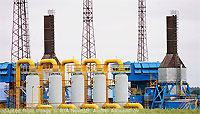SUMMARY: Gazprom’s Wednesday the thirteenth

NOVO-OGARYEVO. Feb 14 (Interfax) – The day former Gazprom (RTS: GAZP) chief Rem Vyakhirev was laid to rest also proved to be grave in terms of the company’s strategic outlook. Russian rivals and officials have been talking seriously about ending the company’s export monopoly, approaching this delicate issue by scrapping the monopoly on LNG exports from offshore fields. Russian producers have already voiced their desire to control their own gas exports, but never as loudly as yesterday.
Oct 23 2012
Gazprom’s export monopoly still looked as safe as houses just three months ago. Even Rosneft (RTS: ROSN) chief Igor Sechin gave his backing.
“Gazprom can export gas and we support this setup. I believe that it would be harmful to shake up the organization of a single export channel,” he said on October 23. Sechin said that cancelling the gas export monopoly would render the system of Russian crude supplies abroad inefficient and could cause sales volumes to fall. There are various options that would allow companies to strike agreements with Gazprom, he said.
Feb 13, 2013
But the need to harness the shelf together with technologically rich but fastidious and demanding international partners and vie for new markets alters the outlook somewhat. “I suggest the liberalization of the export of LNG produced from gas deposits located partially or fully in territorial waters, on the continental shelf, on the peninsulas of Yamal and Gydan; and that stimulatory tax and customs measures be taken,” Sechin said at a meeting of the presidential fuel and energy commission on February 13.
“The liberalization of LNG that we are proposing will not cause harm to our main gas producer, Gazprom, since deliveries will be made to supply fundamentally different markets. If Russian LNG doesn’t go there, they will simply be occupied by other suppliers,” Sechin said, adding that he was speaking primarily of markets in the Asia-Pacific Region.
“The provision of economically beneficial conditions for LNG exports is a matter not just of developing the gas industry, but also of the efficiency and advisability of developing the shelf and, after all, of the future of the Russian fuel and energy sector,” he said.
LNG production could take place within Rosneft’s projects in the Kara Sea and on Sakhalin. In fact, LNG from the Kara Sea projects could be exported via the Northern Sea Route, Sechin said. Twenty-one trillion cubic meters of gas resources have been detected at the sections allocated to Rosneft. In the Kara Sea, 11 trillion cu m of gas have been uncovered at projects already being implemented by Rosneft, he said. “These resources are specified in the license. Selective resource extraction is punishable even by prosecution,” Sechin said.
The authorities
“For the development of such a sector, all the conditions need to be put together, this includes the need to think through the possible gradual liberalization of LNG exporting,” President Vladimir Putin said at the February 13 meeting.
Putin stressed the growing role of the LNG market and said Russia has to get more actively involved in it. At present, Russia accounts for just 3.6% of global LNG supplies.
“If we don’t drive an active policy, we risk almost completely giving away this market to our competitors,” Putin said.
He pointed out the need to account for the fact that around ten years are needed to create modern LNG production capacities, besides which this is a very capital-intensive project.
“We need to think about amounts of investment in new LNG projects in the world, about the growth rates of gas consumption. These things need to be compared with another factor – with the factor of entering into contracts to sell this LNG,” Putin said.
Deputy Prime Minister Arkady Dvorkovich said on February 13 that the government would approach lifting the monopoly on LNG exports cautiously. We’ve been instructed to work out the issue of liberalization, we haven’t stopped discussing it,” he said.
“There are many nuances here. The main thing is to provide guarantees of non-competition on the same LNG markets. How to ensure non-competition is a big question,” Dvorkovich said.
Sakhalin + Alaska = Friendship
The same day of this wave of optimism regarding liberalization, Rosneft and ExxonMobil signed a memorandum to explore the possibility of building an LNG plant in the Russian Far East.
Rosneft and ExxonMobil will consider the economic advisability of building an LNG plant in Russia, the head of ExxonMobil’s Russian division Glenn Waller told reporters, adding that they will look at joint gas resources in Sakhalin.
Rosneft is getting the option for a 25% stake in the Point Thomson project in Alaska under the basic terms of its agreement with ExxonMobil. “Participation in the Point Thomson project will increase Rosneft’s access to the latest gas and condensate field development technologies used in harsh climatic conditions,” Rosneft’s Sechin said of the agreement.
Arctic to judge all
The fuel and energy commission meeting was notable for the absence of Gazprom’s current CEO, Alexei Miller, who was on the list of participants.
There are both objective and subjective reasons for Gazprom delaying the launch of Russia’s very own LNG production. The gas industry has been seeking approaches to the main project, the Shtokman field in the Barents Sea, for nearly a quarter of a century and it’s still not certain when it will start. And Rosneft will find out very soon just how do-able its own Kara Sea and Sakhalin gas projects are from the technological and economical point of view.
